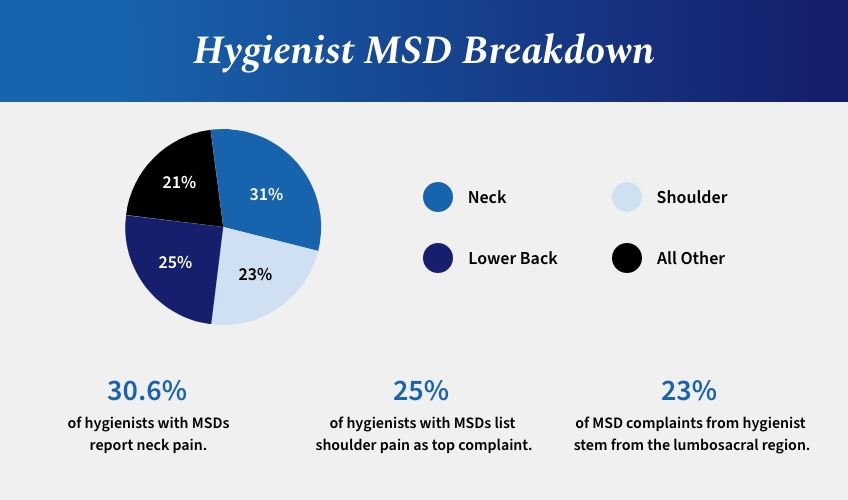The Importance of Ergonomics in Dentistry: How Staff Well-Being Supports Practice Resiliency
By Spear Team on October 27, 2022 | commentsAnywhere from 60 to 96% of dental hygienists report some type of musculoskeletal disorder (MSD) from their work. Whether it is cervical spine injuries from spending hours hunched over patients, or carpal tunnel syndrome from days of cleaning teeth, dental workers face a greater risk from poor ergonomics than other workers. That is why the importance of ergonomics in dentistry cannot be underestimated.

MSDs are not just a matter of pain or inconvenience for hygienists. Left unchecked, they become career enders. In fact, more than half (55%) of ill health retirements are attributed to these types of injuries. That means less experience in the office and the industry. By addressing ergonomics early on, we can mitigate some of these issues.
The True Costs of MSDs in the Dental Industry
Musculoskeletal disorders are injuries to the joints and connective tissues that occur because of overexertion or repetitive motion rather than a single traumatic event. In dental offices, where team members work in small spaces, perform repetitive tasks, and stand in awkward positions, these MSDs are particularly prevalent. There are three areas that make of the brunt of most work-related MSD complaints: the neck, the shoulders, and the lower back.

A hygienist suffering from one of these conditions is going to have lower morale, more days out of the office and lower overall productivity. In some cases, they may decide to change careers entirely. That's a major concern, as 8% of hygienists left the industry at the start of the pandemic and less than half have returned.
Typically, someone who must leave the field due to an MSD is a highly experienced, skilled worker. These injuries do not appear overnight. They take years to develop. That is why, if dental offices are going to address these issues, they need to look at long term solutions and specifically, ergonomics.
The Principles of Ergonomics
Humans are built to adapt. When we enter an unfamiliar environment, we adjust ourselves to fit it, and not the other way around. However, this adaptability has a negative side. Workers will modify their working style for their office and equipment given to them. That creates a situation where MSDs are all but guaranteed.
Ergonomics is designed to adapt the environment to the worker. This helps them maintain better positions and practices that limit their risk of injury. Specifically, ergonomics addresses design, adjustment, and arrangement of physical spaces.

By focusing on these three areas, dental practices can go a long way towards improving the longevity of dental staff and driving practice success.
Reinforcing the Importance of Ergonomics in Dentistry
Establishing an ergonomic dental office is not a quick fix. It is a process that will require a deep understanding of the practice and its staff. It can be broken into three phases that include analysis, investment, and education.
Analyze and Assess
Even a small practice can benefit into a deep dive into the data to understand how MSDs are affecting their bottom line. Reviewing information related to workers compensation claims, employee absences and workplace injuries can help a practice understand how to improve the well-being of staff. It's also critical to review workstations to ensure they're designed with dental staff safety and comfort in mind.
Invest in Improvements
With data in hand, dental practice managers can look at potential investments that will improve ergonomics. Simple, inexpensive additions like computer risers or ergonomic instrumentation can help cut down on many common complaints, while individual workstation assessments by a professional can target key issues.
Educate Staff
Finally, a big part of ergonomics is undoing unhealthy habits and poor muscle memory that workers learned in non-ergonomic environments. Many individuals who suffer from MSDs are not aware of the simple changes they could make to improve their health.
When workers understand the importance of ergonomics in dentistry, they're more prepared to protect their health. Too many hygienists write off neck, back and shoulder pain as a hazard of the profession. But with ergonomic support, dental practices can protect them and drive retention of key personnel.
Spear offers a detailed course, “The Ergonomics Woes of The Dental Professional,” that you can use to help improve worker well-being.